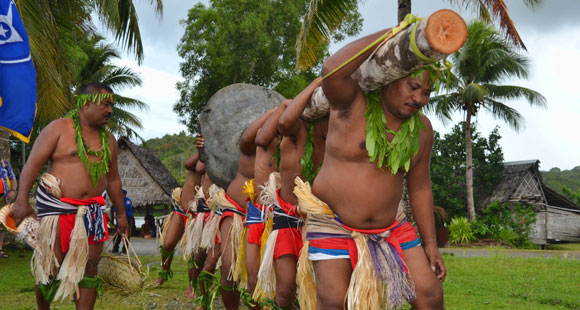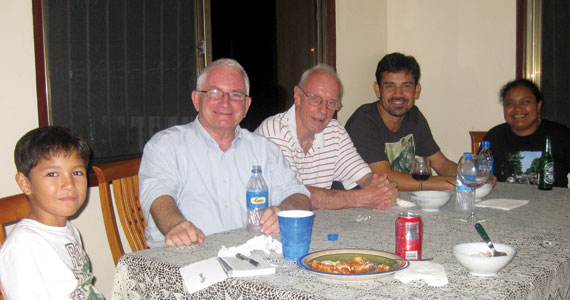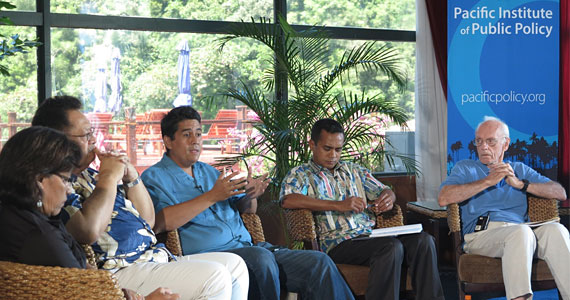Yap and Palau: The Far Edge of Micronesia
This is a shortened version of a talk I gave at Yap Homecoming Day on June 15. The theme of the event was the link that binds Yap and Palau.
Yap and Palau, at the extreme western end of Micronesia, have always had an air of mystery around them–at least to us Westerners.
For one thing, their languages are so different from the rest of Micronesia–Palau the Polish of Oceania with all its consonants, and Yap with its closest relative being a Guatemalan language, a linguist friend tells me.
In some ways, the island groups seem to be opposites. Yap: conservative, slow to change, proud of its culture and its past. Palau: go for broke, keep up with the changes, get a good education and make a place for yourself in the modern world. One is taking the fast track, and the other is in the slow track.
But that?s not quite true, when we take a hard look at their history. Palau may be famous for keeping up with the rest of the world these days, but bear in mind that it was the last island group in Micronesia to modernize. On the other hand, Yap was trading for whiskey for 30 years before the end of the century. Yapese might have been wearing grass skirts and loincloths, but they knew what tools and cooking utensils were being offered at the trader?s stores and how much copra it would cost them.
Both Yap and Palau share strong features in their cultures:
- Strong village organization?stronger than anywhere else in Micronesia, I can tell you. In both groups there are chiefs ?the voice of the land? with village councils, seats assigned to heads of ranking clans. Their council houses nearly share the same name?bai in Palau, and pebay in Yap.
- Competition deeply built into their system. Palau: with everything split into halves?this side and that side. Clubhouses within villages, villages into confederations, one under Koror and the other under Melekeok. Yap: everything divided not into halves, but into thirds?like the three legs of a stool, as the Yapese say.
- Traditional valuables, or what could be called ?local money.? Both places had something that no one else in Micronesia had: In Palau, it was beads and pieces of ceramic rims. In Yap it was limestone discs and the different kinds of shell money. The ?money? was valuable, of course, because it was hard to get.
The most obvious feature in the relationship between Yap and Palau was the voyages of Yapese to Palau to quarry those famous discs of limestone money.
One legend tells of the first stone money cut in Palau: A crew from Tomil went to Palau to quarry stone money but couldn’t figure out how to get it back to Yap. So they enchanted a butterfly that guided the canoe and raft back to Yap. Limestone money discs were afterwards called ?stones of the butterfly.?
Another tradition tells of two Yapese, Fatha?an (from Rul) and Anguman (from Tomil), sailing to Palau and discovering a beautiful white stone. At a place in the Rock Islands, they found the white stone and cut it into different shapes, but finally selected the circular shape since it was like the full moon. They returned to Yap separately, after a war of magic on the way to create high seas.
When did the contact between Yap and Palau for stone money begin?? We?re not sure, but certainly before the arrival of Westerners. But we do know that at some point special ties were developed: Rul with Koror and Airai, and Gagil with Melekeok.
Yapese got their stone money from Palau, but they brought exchange items with them. Bead money (bachel) was one of the items. They also brought to Palau turmeric?the deep red turmeric produced in Gagil that is still a luxury product today. But there are stories Yapese tell of work that they performed when in Palau: The path up to the men?s house in Melekeok was paved by people from Gagil. The long causeway to Meyungs was paved by the people of Rul. The causeway to Malakal was paved by the people from Outer Islands, Rumung and Maap.
This relationship between the two island groups, then, resulted in an exchange of valuables (bachel and rai), and services performed by Yap for Melekeok and Koror. This seems to have been advanced by the intermarriage of ranked persons between the two groups, even extending?? to some of the higher titles in Palau.
There is much about the past that we don?t know, of course. About the ties between the two places and how they changed with time. When the stone money trade really began? What role the Outer Islanders played in all this?
These are important questions relating to the past. But, as Pohnpeians like to say, the answers to these questions are ?lost in the weeds.? Maybe the time has come to bring out the machete or weed-whacker and find the answers.






